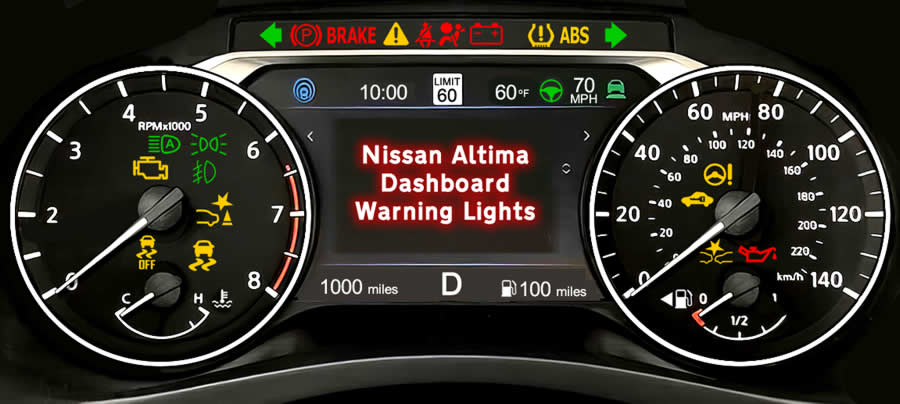Nissan Altima Dashboard Warning Lights
The Altima has been produced by Japanese car manufacturer Nissan since 1992. The following warning lights cover the latest versions of the Altima, but will also be of use to older versions of the car. Each Nissan Altima warning symbol’s meaning is explained, along with the manufacturer’s recommended action to take.
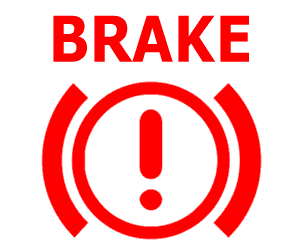 Brake Warning Light
Brake Warning Light
Depending on your version of Nissan Altima, this red warning light either displays as the text ‘BRAKE’, or as the symbol containing an exclamation point. The brake warning light doubles up firstly as a warning that the parking brake is on and secondly, if the parking brake is released and the light stays on, it means the vehicle’s brake fluid level is low.
In this case of the second option, check the vehicle’s brake fluid levels. If brake fluid level is sufficient, do not drive the vehicle and contact a Nissan workshop. For brake fluid, use Nissan Super Heavy Duty Brake Fluid or equivalent DOT 3. Note: This warning light comes on briefly with the ignition as a bulb check.
 Charge Warning Light
Charge Warning Light
This red battery charge light comes on initially with the ignition as a bulb check, the goes off. It it remains on, or comes on when you’re driving, it means there’s an electrical charge fault.
This is usually an problem related to the generator / alternator, or its drive belt. Also check battery connections and have the battery tested. Continued driving may see the engine stop. Make your way directly to your nearest auto workshop.
Note: Do not ground electrical accessories directly to the battery terminal. Doing so will bypass the variable voltage control system and the vehicle battery may not charge completely. See why is my car battery warning light on for further information.
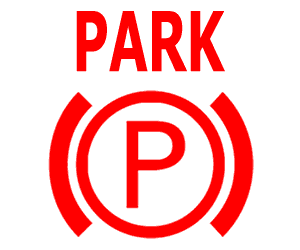 Electronic Parking Brake Warning Light
Electronic Parking Brake Warning Light
Depending on your version of Nissan Altima, this red warning light either displays as the text ‘PARK’, or as the symbol. This red symbol illuminates when the electronic parking brake system is operating.
When the ignition switch is placed in the ON position, the electronic parking brake warning light illuminates. When the engine is started and the parking brake is released, the warning light turns off. If the parking brake is not released, the electronic parking brake warning light remains illuminated.
A fault with the electronic parking brake is indicated by a flashing electronic parking brake symbol along with a yellow brake warning light ![]() . A yellow electronic parking brake symbol with a wrench next to is is also used.
. A yellow electronic parking brake symbol with a wrench next to is is also used.
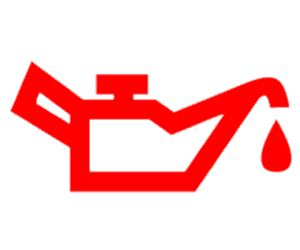 Engine Oil Pressure
Engine Oil Pressure
This light warns of low engine oil pressure and is not designed to warn of low oil level. If the light flickers or comes on during normal driving, pull off the road in a safe area, stop the engine immediately.
Though this light does not warn of low oil level, very low oil levels can cause low pressure, resulting in the light coming on. check oil levels and if low, top up immediately. Only continue to drive if the light extinguishes as driving with the low engine oil pressure light will result in serious engine damage almost immediately.
 Master Warning Light (Red)
Master Warning Light (Red)
The red triangle containing an exclamation point is the Nissan Altima master warning light. The red master warning light will illuminate along with these other warnings:
- Parking brake release warning
- Door open warning (while moving)
- Steering Alert hands on detection warning
The warnings remain on the vehicle information display until action is taken, or the ignition is placed in the off position.
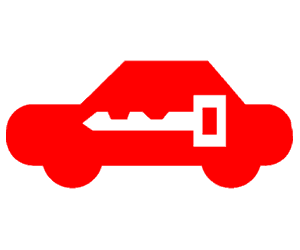 Security Warning Light
Security Warning Light
The red car and key symbol is the Nissan Altima security immobilizer warning light. Under normal operating conditions, the security light blinks when the ignition switch is placed in the off, lock or auto ACC position. The blinking security light indicates that the security systems on the vehicle are operational.
If the vehicle immobilizer system is malfunctioning, the light will remain on while the ignition switch is placed in the ON position. If you’re unable to start the car, the first step is to try another key if you have on, or check the battery inside the electronic key. Another common problem is your vehicle’s battery being dead, or not enough charge.
 Airbag Warning Light
Airbag Warning Light
As part of the self-check system, the Nissan Altima airbag warning light comes on for around 7 seconds when the ignition switch is placed in the start, or On Position. The light should then go off if all is working properly.
If any of the following conditions occur, the front air bag, side air bag, curtain air bag, and seat belt pretensioner systems have a fault:
- The supplemental air bag warning light remains on after approximately 7 seconds.
- The supplemental air bag warning light flashes intermittently.
- The supplemental air bag warning light does not come on at all.
Common causes for an airbag or seat belt pretensioner systems can include airbag sensor damage, airbag clock spring, airbag module, debris inside seat belt buckle, cables / connections under the front passenger seats loose. A good diagnostic tool should be used to scan for fault codes.
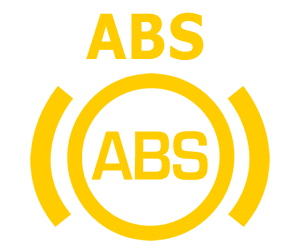 ABS Warning Light
ABS Warning Light
Most new cars come with ABS fitted as standard. ABS stands for Anti-lock Braking System and means that when the driver brakes, typically during an emergency, the wheels are prevented from locking, therefore allowing the driver to steer the car.
ABS is a separate components to the Nissan Altima’s brakes, so if ABS fails, the vehicle’s brakes will continue to operate. Most often, an ABS fault is due to a damaged wheel speed sensor – one on each wheel.
 Automatic Emergency Brake Warning Light
Automatic Emergency Brake Warning Light
The Automatic Emergency Brake (AEB) with Pedestrian Detection system can assist the driver when there is a risk of
a forward collision with the vehicle or pedestrian ahead in the same traveling lane.
If AEB determines that there’s a risk of collision, the system will first flash the warning light along with an audible alert. IF the driver does not brake, or fails to brake in time, AEB will apply the vehicle’s brakes.
This light illuminates when the AEB with Pedestrian Detection system is set to OFF in the vehicle information display. If the light illuminates when the AEB with Pedestrian Detection system is on, it may indicate that the system is unavailable.
The AEB with Pedestrian Detection system uses a radar sensor located on the front of the vehicle’s grille to measure the distance to the vehicle ahead in the same lane. For pedestrians, the AEB with Pedestrian Detection system uses a camera installed behind the windshield in addition to the radar sensor. Ensure that these areas are kept clean for optimal working conditions.
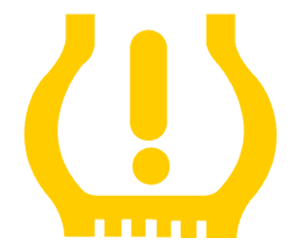 Tire Warning Light
Tire Warning Light
The Nissan Altima Tire Pressure Monitoring System (TPMS) constantly monitors the pressures in each of the vehicle’s tires. If one of the tire’s pressure is determined to fall under the set pressure values, a the tire warning light will come on.
In this instance, you should stop and adjust tire pressure to the recommended cold tire pressures located inside the driver’s door. To reset the tire warning light after pressure adjustment, drive the vehicle at speeds above 16 mph (25 km/h) to activate the TPMS and turn off the low tire pressure warning light.
If the low tire pressure light flashes for around 1 minute, then stays on, it means the TPMS is not working properly, or one of the tires (such as the spare) may not have a pressure sensor installed. Pressure sensors can be damaged or the battery inside the sensor exhausted. External radio waves can also interfere with the TPMS causing the light to come on. The tire warning light may also flash if the TPMS has been replaced and the ID has not been registered, or if wheels that are not specified by Nissan are used.
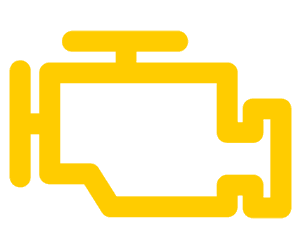 Engine Warning Light
Engine Warning Light
The Nissan Altima engine warning light stays illuminates when the engine’s running if there’s an emissions fault. The emissions control system has determined that there’s a fault and the warning light comes on. On certain versions of the Nissan Altima, a SERVICE ENGINE SOON warning light comes on instead.
The engine warning light may also comes on due to a loose fuel filler cap. The vehicle’s Evaporative Emissions control system will trigger the engine warning light it it determines gasoline vapors are escaping. Check the cap is tightly secured and not damaged. It may take a few driving trips before the light goes out.
If the engine warning light remains lit, it’s likely there’s a problem with a component that makes up part of the vehicle’s emissions control. These components vary from spark plugs, to sensors, right up to the catalytic converter. When the engine warning light comes on, a fault code is usually generated and stored. Diagnostic equipment plugs into the Altima’s OBD II port and scans for fault codes. Once found and read, the diagnostic tool should help locate the fault. You can usually continue to drive if the engine light is on (non-flashing).
If the engine warning light is flashing, it means an engine misfire has occurred. This can cause damage to the catalytic converter. In this instance:
- do not drive at speeds above 45 mph (72 km/h).
- avoid hard acceleration or deceleration.
- avoid steep uphill grades.
- if possible, reduce the amount of cargo being hauled or towed.
The engine light may stop blinking if you follow the above procedure. If the engine light continues to blink, it’s advised that you stop driving the vehicle and contact a Nissan workshop. On certain versions of the Nissan Altima, a SERVICE ENGINE SOON warning light blinks instead. For more understanding of the engine warning light, see reasons why the engine warning light is on.
 Master Warning Light (Yellow)
Master Warning Light (Yellow)
When the ignition is in the ON position, the Nissan Altima yellow master warning light illuminates if any of the following are displayed on the vehicle information display.
- No key warning
- Low windshield-washer fluid warning
- Door open warning (when stopped)
- Trunk open warning
- Loose fuel cap
- Low tire pressure warning
- AWD (all-wheel drive) warning
There should be a warning message to accompany the yellow master warning light. If there isn’t, use the buttons of the steering wheel to navigate to the vehicle information display until the ‘warnings’ screen is displayed.
 Rear Automatic Braking Warning Light
Rear Automatic Braking Warning Light
The Nissan Altima Rear Automatic Braking (RAB) system can assist the driver when the vehicle is backing up and approaching objects directly behind the vehicle. The RAB system detects obstacles behind the vehicle using the four parking sensors located on the rear bumper.
The RAB light comes on when the ignition switch is placed in the ON position and turns off after the engine is started. This light illuminates when the RAB system is turned off in the vehicle information display. If the light illuminates when the RAB system is on, it may indicate that the system is unavailable. Ensure the rear bumper is free from mud, snow etc and that you do not place stickers in the vehicle’s bumper. A light collision may damage the RAB sensors.
 Power Steering Warning Light
Power Steering Warning Light
The power steering system is designed to provide power assistance while driving to operate the steering wheel with light force. When the power steering warning light illuminates with the engine running, there will be no power assist for the steering, but you will still have control of the vehicle. At this time, greater steering effort is required to operate the steering wheel, especially in sharp turns and at low speeds.
When the steering wheel is operated repeatedly or continuously for extended periods while parking or driving at a very low speed, the power assist for the steering wheel will be reduced. This is to prevent overheating of the power steering system and protect it from getting damaged. While the power assist is reduced, steering wheel operation will become heavy.
If the steering wheel operation is still performed, the power steering may stop and the power steering warning light will illuminate. This indicates that the power steering motor has temporarily overheated. Normal operation will resume once the system has cooled.
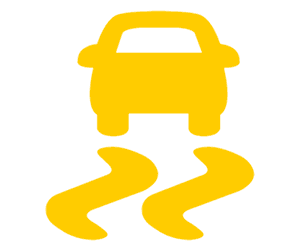 Vehicle Dynamic Control Warning Light
Vehicle Dynamic Control Warning Light
The Nissan Altima Vehicle Dynamic Control (VDC) system makes use of wheel speed sensors, steering angle sensor, yaw rate, and lateral acceleration sensor to monitor driver inputs and vehicle motion. Under certain driving conditions, the VDC system helps to perform the following functions:
- Controls braking to reduce wheel slip (Traction Control)
- Controls braking and engine output to minimize oversteer and understeer
When the VDC light blinks, it means the system is actively operating to maintain control of the vehicle. On certain versions of the Nissan Altima, the SLIP light may blink indicating that traction control is operating.
If the VDC light remains content lit, it means the system has a fault. A fault code will typically be generated, so diagnostics is recommended. The usual cause for a malfunctioning VDC is a damaged wheel speed sensor. Note: VDC is sometimes disabled if you are having engine troubles (the engine warning light is on). This is so that the VDC system doesn’t interfere with reduced engine power mode. VDC is similar to ESC. For more information, see What ESC is in Cars and How Does ESC Work in Cars.
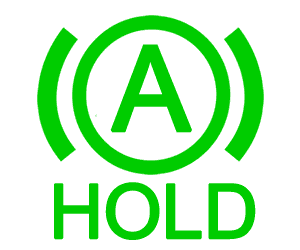 Automatic Brake Hold Warning Light
Automatic Brake Hold Warning Light
The automatic brake hold function maintains the braking force without the driver having to depress the brake pedal when the vehicle is stopped at a traffic light or intersection. As soon as the driver depresses the accelerator pedal again, the automatic brake hold function is deactivated and the braking force is released.
The white automatic brake hold indicator light illuminates when the automatic brake hold system is on standby. The green automatic brake hold indicator light illuminates when the automatic brake hold system is operating.
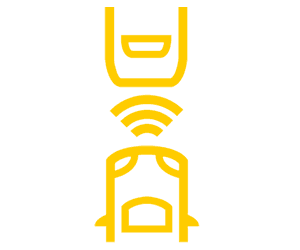 Vehicle Ahead Warning Light
Vehicle Ahead Warning Light
This vehicle ahead indicator shows on the dashboard when the following systems are engaged and have detected a vehicle:
- Automatic Emergency Braking (AEB) with Pedestrian Detection
- Intelligent Forward Collision Warning (I-FCW)
 O/D OFF Warning Light
O/D OFF Warning Light
The Nissan Altima Overdrive (O/D) function is ideal for highway driving. Having Overdrive on allows the vehicle to travel at high speeds whilst reducing the engine’s revolutions. This allows for improved fuel economy and a quieter driving experience. Overdrive can be turned off with a press of a button.
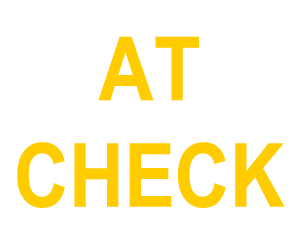 AT CHECK Warning Light
AT CHECK Warning Light
The Nissan Altima AT CHECK warning light refers to the vehicle’s automatic transmission. When the system detects a fault with the automatic transmission, the AT CHECK warning light illuminates.
To help prevent damage to the automatic gearbox, the vehicle may enter reduced performance mode. In this instance, the vehicle may drive and operate more slowly than usual. Have the vehicle diagnostics checked and scanned for fault codes.
CVT Fault Messages
The Nissan Altima CVT stands for continuously variable transmission and is a type of automatic transmission. The following warning messages relate to the vehicles CVT.
Service CVT
This warning message appears when a fault has been detected with the vehicles’ CVT. Diagnostics is required.
CVT Hot Power Reduced
The Nissan Altima CVT has a high fluid temperature protection mode. If the fluid temperature becomes too high engine power and, under some conditions, vehicle speed will be decreased automatically to reduce the chance of transmission damage.
Vehicle speed can be controlled with the accelerator pedal, but the engine and vehicle speed may be reduced. Transmission temperature may become too high due to climbing steep grades in high weather temperatures with heavy loads, such as when towing a trailer. If possible, reduce speed or pull over to the side of the road and allow the transmission to return to safe operating temperatures.
CVT (AT) Malfunction Service Now
This is another malfunction warning appears that appears due to the automatic transmission (AT). If this warning comes on, have the system diagnosed by a Nissan workshop.
CVT (AT) Stop the Vehicle
The Stop The Vehicle message appears 30 seconds before the vehicle is shut down due to an above normal operating transmission temperature. The engine warning light and malfunction warning (red triangle with exclamation point) will illuminate. Have the system checked and diagnosed by a Nissan workshop.
Engine Fault Messages
The following engine fault messages may display on the Nissan Altima dashboard:
Engine Stalled: Stop Safely
The Engine Stalled: Stop Safely message appears 30 seconds before the vehicle is shut down due to an above normal operating exhaust temperature. The engine warning light and malfunction warning (red triangle with exclamation point) will illuminate. Have the system checked for fault codes and diagnosed by a Nissan workshop.
Engine Malfunction Power reduced Service Now
This warning message appears when the engine is not operating under normal conditions and a malfunction has been detected. If
this warning appears, have the engine checked for fault codes and diagnosed by a Nissan workshop.
Engine Malfunction Service Now
This warning appears when there is a problem with the engine. If this warning appears, have the engine checked for fault codes and diagnosed by a Nissan workshop.
Engine Hot Power Reduced
This Nissan Altima engine has a high fluid temperature protection mode. If the fluid temperature becomes too high, engine power and, under some conditions, vehicle speed will be decreased automatically to reduce the chance of engine damage (reduced engine power mode). Vehicle speed can be controlled with the accelerator pedal, but the engine and vehicle speed may be reduced. It’s advised that you safely stop the vehicle to allow coolant and engine oil temperatures to return to normal operating temperatures.
